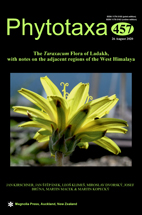Abstract
Ladakh (Jammu & Kashmir State, NW. India) is a region in the Trans-Himalaya between the Great Himalayan Range in the south and the eastern Karakoram in the north, at the southwestern edge of the Tibetan Plateau. Its flora, vegetation, ecology and climatic conditions were thoroughly studied by the late Leoš Klimeš. As regards the genus Taraxacum (Compositae-Crepidinae), Ladakh was an almost unexplored area. L. Klimeš accumulated an ample material (50 Ladakh species are exclusively based on his material), either as field samples or as cultivated specimens; together with further recent collections of other collectors, cultivated by JK & JŠ, and the historical herbarium material, it forms a basis for the present monograph. It presents a taxonomic treatment of all Taraxacum species documented from Ladakh, including notes on ecology and distribution, and notes on dandelions from adjacent regions, mainly Gilgit-Baltistan, Spiti, Lahaul and the cis-Himalayan Kashmir. Each species is characterized by a full description, photographs of involucre, capitulum and achenes, whenever available; species are arranged systematically in sections, the latter also with descriptions and identification keys including all the taxa from Ladakh and adjacent areas. Treatments of five sections include all or almost all of their members. Distribution maps and a complete list of specimens studied are given for all Ladakh dandelions. A comprehensive introduction in the vegetation of Ladakh, general features of the genus Taraxacum and the history of its exploration are also provided. As regards the Taraxacum diversity, the broader region covered by the present monograph includes representatives of one third of the world sectional diversity. One hundred and twenty one taxa, belonging to 19 sections, are given a full tratment in the monograph, including those from adjacent regions (the latter, 46 species, also with full descriptions and illustrations); the Ladakh proper harbours 76 taxa in 17 sections, one of which is described as new. Fifty one taxa are described as new for science, 42 from Ladakh, 9 from other regions. For all species, the mode of reproduction is given (mostly inferred from indirect indicators). Only seven species were found at least partly sexual (five of them outside the limits of the Ladakh proper); all the other taxa exhibit agamospermy. Ladakh and adjacent regions of Pakistan and India rank among the regions with the highest sectional and morphological Taraxacum diversities.

